

Fitness Is a Skill, Not a Talent: Here's How to Develop It. Understanding What a Push/Pull Weight Training Routine is and How to Implement it - In general, each primary muscle group is considered to be either a push muscle group or a pull muscle group.
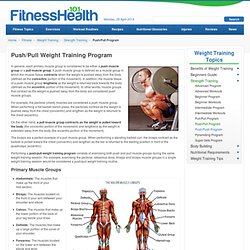
A push muscle group is defined as a muscle group in which the muscle tissue contracts when the weight is pushed away from the body (defined as the concentric portion of the movement). In addition, the muscle tissue of a push muscle group lengthens as the weight is returned back towards the body (defined as the eccentric portion of the movement). In other words, muscle groups that contract as the weight is pushed away from the body are considered push muscle groups. For example, the pectoral (chest) muscles are considered a push muscle group. When performing a flat barbell bench press, the pectorals contract as the weight is pushed away from the chest (concentric) and lengthen as the weight is returned to the chest (eccentric).
Top 20 Bodyweight Exercises for Building Muscle & Strength. Bodyweight exercises need to be part of your program if you want to get jacked.
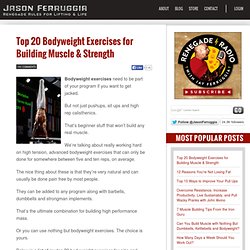
But not just pushups, sit ups and high rep calisthenics. That’s beginner stuff that won’t build any real muscle. Training Tips: Plan Your Workout! 25 Tips For More Muscle And Superstrength! By Muscle & Fitness Last updated: Aug 17, 2012 Lift barefoot, if possible, or in minimalist footwear like Vibram FiveFingers shoes, wrestling shoes, or converse chucks. having your feet flat on the floor lessens the distance you have to pull the bar on a deadlift, increasing your leverage and helping you lift heavier weights.
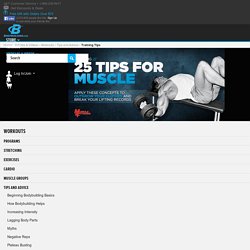
Training barefoot also strengthens your feet, which in turn adds stability and traction to all your lifts. Squeeze your glutes at all times during a set, especially on lifts like the bench press and overhead press. It stabilizes your entire torso. If the total number of reps you perform for an exercise adds up to 25, you're more likely to maximize muscle and strength gains. Train with heavy loads one month, using sets of four to six reps. Hold an 8- to 10-pounder and throw it hard into a wall a few feet in front of you, as if you were passing a basketball down the court. Want to look leaner without dieting? Fat Gripz Find Fat Gripz on our store. About The Author. - StumbleUpon. Muscle Physiology - Oh Those Crazy Muscles! When the average person takes a look at a bodybuilder all he sees is a series of lumps and bumps of varying shapes and sizes.
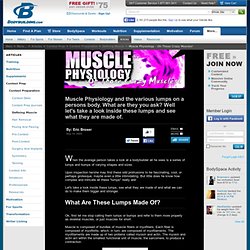
Upon inspection he/she may find these odd protrusions to be fascinating, cool, or perhaps grotesque, maybe even a little intimidating. But little does he know how complex and intricate all these "lumps" really are! Let's take a look inside these lumps, see what they are made of and what we can do to make them bigger and stronger. Ok, first let me stop calling them lumps or bumps and refer to them more properly as skeletal muscles, or just muscles for short. Muscle is composed of bundles of muscle fibers or myofibers. It is the myosin protein, however, which holds the key to the differences in muscle fiber types. Muscle Fibers: How Do They Differ? Our body is composed of many different groups of muscles and each person has a unique composition of muscle tissue in their body.
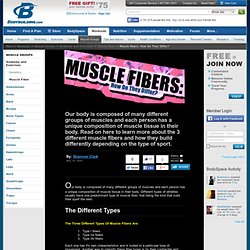
Different types of athletes usually have one predominant type of muscle fiber, that being the kind that suits their sport the best. Each one has it's own characteristics and is suited to a particular type of movement. Another way to classify these fiber types is by their contractile and metabolic properties, thereby dividing them into slow and fast twitch fibers.
Type I: Slow Twitch Fibers. The first type of fiber we will look at is the type I, or slow twitch fibers. Physically, these fibers are red in appearance, due to their iron containing cytochromes, have a small fibers diameter and have many capillaries throughout their structure. Type IIa: Fast Twitch Fibers. Muscle Mass Accretion Training: My Top 3 Mass-Building Tips! Let's be honest about being successful in bodybuilding, the key to building a championship physique on any stage relies heavily on muscle mass and density.

The traditional rep range of 8-12 reps just does not cut it when it comes to building true and hard-earned muscle. Rep ranges are based on these specific muscle-fiber characteristics (Kravitz, 2007) (See Chart Below): Accordingly, the size principle, which indicates that order of muscle fiber type recruitment follows the following pattern: Type I Type IIa Type IIb. 10 Pushup Variations for a Stronger Body Slideshow. 20 Ways to Instantly Improve Your Life Slideshow. Catherine Yeulet/iStock/Getty Images Overview Most diet and fitness plans are like long cross-country car rides.
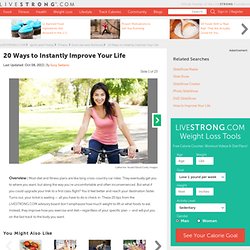
They eventually get you to where you want, but along the way you're uncomfortable and often inconvenienced. Ask The Macro Manager: Are Raw Foods Really More Nutritious? I'm concerned that I may be overcooking vegetables, and that I'm not getting the needed nutrition.

Does a raw food diet give me that much more in the way of micronutrients from food? . Cooking vegetables--especially overcooking them--can reduce levels of both fat-soluble (A, E, K, and D) and water-soluble (B and C) vitamins. But despite the potential loss of some vitamins during the cooking process, certain nutrients actually become more available to your body after you cook them. For example, your body absorbs more lycopene, an antioxidant found in tomatoes, from cooked and processed (e.g. tomato paste, salsa, etc.) products compared to fresh tomatoes. Kelechi Opara's Muscle Building Program.
By Fitness 360 May 16, 2011 When training to build muscle, Kelechi Opara stays "hungry" from an innate urge to fulfill his potential in life by continually improving himself personally each and every day.
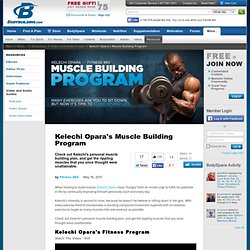
Kelechi's intensity is second to none, because he doesn't be believe in sitting down in the gym. Steve Cook Muscle Building Program. By Fitness 360 Mar 07, 2012 Learn all of Steve Cook's strategies and tips for packing on serious size.
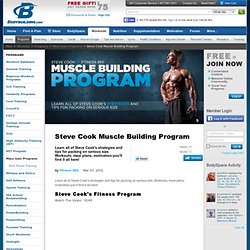
Workouts, meal plans, motivation-you'll find it all here! Steve Cook's Fitness Program. Dorian Yates - Blood & Guts 6 Week Trainer Main Page! Push beyond your limits and unlock new pathways of extreme growth as you follow the mass routine created by legendary 6-Time Mr. Olympia Dorian Yates. Prepare to take on the very same body-shocking failure sets that elevated him into legend, and will test your threshold of possibility. About The Author Check out these awesome articles by some of the best writers in the industry.